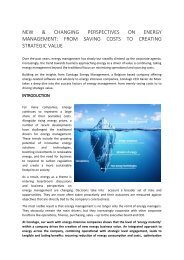Accurate Allocation of energy in production processes - the importance of using metamodels
Many companies struggle with correctly monitoring, allocating and distributing direct and indirect energy consumption over all internal and external customers, users or products. In this age of rising commodity costs and additional attention to sustainability, the advantages of adequately allocating energy are nonetheless substantial: 1. Real-time mapping of energy throughout process flows makes it easier to detect deviations in energy conversions during production processes, find the root causes and reduce losses. 2. Using exact and objective keys for allocating energy consumption speeds up periodic P&L and CSR reporting and makes for more accurate reports. 3. Continuous, real-time distribution of energy cost among users increases transparency and raises awareness with them. Although most companies already struggle with integrating correct data from metered equipment, this is only the first - albeit important - step. The crux is fully understanding the nature and efficiency of energy conversions processes; energy inflows and outflows to different customers; fixed and variable costs and corporate structures. By using metamodels - designed for and maintained by energy managers - all this information is added to the initial metered data and processed in such a way that any change from an energy point of view instantly leads to adjustments in the energy allocation. This white paper reviews emerging trends and challenges in energy allocation and examines the working and benefits of using specific metamodels at the level of energy management software.
Many companies struggle with correctly monitoring, allocating and distributing
direct and indirect energy consumption over all internal and external customers,
users or products. In this age of rising commodity costs and additional
attention to sustainability, the advantages of adequately allocating energy are
nonetheless substantial:
1. Real-time mapping of energy throughout process flows makes it easier
to detect deviations in energy conversions during production processes,
find the root causes and reduce losses.
2. Using exact and objective keys for allocating energy consumption
speeds up periodic P&L and CSR reporting and makes for more accurate
reports.
3. Continuous, real-time distribution of energy cost among users increases
transparency and raises awareness with them.
Although most companies already struggle with integrating correct data from
metered equipment, this is only the first - albeit important - step. The crux is
fully understanding the nature and efficiency of energy conversions processes;
energy inflows and outflows to different customers; fixed and variable costs
and corporate structures. By using metamodels - designed for and maintained
by energy managers - all this information is added to the initial metered data
and processed in such a way that any change from an energy point of view
instantly leads to adjustments in the energy allocation.
This white paper reviews emerging trends and challenges in energy allocation
and examines the working and benefits of using specific metamodels at the
level of energy management software.
You also want an ePaper? Increase the reach of your titles
YUMPU automatically turns print PDFs into web optimized ePapers that Google loves.
Example graph based model with CHP and hot water conversions<br />
Source node<br />
Electricity grid<br />
connection<br />
Distribution node<br />
Electricity<br />
S<strong>in</strong>k node<br />
Build<strong>in</strong>g product<br />
l<strong>in</strong>e 1<br />
Source node<br />
W<strong>in</strong>d turb<strong>in</strong>e<br />
Conversion node<br />
Comb<strong>in</strong>ed heat<br />
power<br />
S<strong>in</strong>k node<br />
Build<strong>in</strong>g product<br />
l<strong>in</strong>e 2<br />
Source node<br />
Natural gas grid<br />
connection<br />
Distribution node<br />
Natural gas<br />
Conversion node<br />
Hot water boilers<br />
Conversion node<br />
Hot water<br />
Source node<br />
Water grid<br />
connection<br />
Distribution node<br />
Water<br />
S<strong>in</strong>k node<br />
Build<strong>in</strong>g product<br />
l<strong>in</strong>e 3<br />
Figure 3: Graph-based model example.<br />
As is immediately clear from <strong>the</strong> picture above, a graph-based model is not<br />
restricted to <strong>the</strong> one-on-one relationships between a datapo<strong>in</strong>t and <strong>the</strong> entity<br />
it belongs to. Interpret<strong>in</strong>g total <strong>energy</strong> consumption that went <strong>in</strong>to a batch on<br />
product l<strong>in</strong>e three, for example, is now possible as <strong>the</strong> model can trace back<br />
meter data on how much electricity (and from which sources) was used, which<br />
fraction <strong>of</strong> natural gas was used - both for heat<strong>in</strong>g water and for generat<strong>in</strong>g<br />
electricity - and how much water went <strong>in</strong>. The efficiency <strong>of</strong> <strong>the</strong> hot water<br />
distribution and <strong>the</strong> comb<strong>in</strong>ed heat-and-power (CHP) plant is readily available<br />
from <strong>the</strong> meter read<strong>in</strong>gs and can be taken <strong>in</strong>to account as well.<br />
Do note that hierarchical models can be seen as a less complex <strong>in</strong>stance <strong>of</strong><br />
graph-based ones. In a process where no <strong>energy</strong> sources are comb<strong>in</strong>ed or<br />
converted, every step gets only one <strong>in</strong>put from its predecessor. There would<br />
be only one arrow arriv<strong>in</strong>g at each node - which is <strong>the</strong> conceptual equivalent <strong>of</strong><br />
<strong>the</strong> datapo<strong>in</strong>t/node belong<strong>in</strong>g to a s<strong>in</strong>gle category.<br />
Static vs. versioned models<br />
A second perspective is to dist<strong>in</strong>guish between static models on <strong>the</strong> one hand<br />
and versioned models on <strong>the</strong> o<strong>the</strong>r.<br />
The few s<strong>of</strong>tware packages we found to have been built around <strong>metamodels</strong> <strong>in</strong><br />
<strong>the</strong> first place, were all based on static ones. The word ‘static’, however, does<br />
not necessarily mean <strong>the</strong> metamodel cannot change - <strong>in</strong>deed, one or two <strong>of</strong> <strong>the</strong><br />
packages did <strong>of</strong>fer (limited) options to adjust <strong>the</strong> configuration <strong>of</strong> datapo<strong>in</strong>ts/<br />
meters that are fed <strong>in</strong>to <strong>the</strong> program. They are still ‘static’ <strong>in</strong> our vocabulary,<br />
however, as <strong>the</strong>y lack <strong>the</strong> essential feature: <strong>the</strong>y do not track <strong>the</strong> changes that<br />
were at <strong>the</strong> basis <strong>of</strong> <strong>the</strong> change <strong>in</strong> <strong>the</strong> model. There is no way to uncover <strong>the</strong><br />
alterations to <strong>the</strong> structure <strong>of</strong> <strong>the</strong> <strong>energy</strong> flows, to <strong>the</strong> company structure or<br />
to <strong>the</strong> positions <strong>of</strong> key people. There are, <strong>in</strong> o<strong>the</strong>r words, no pathways that<br />
14




